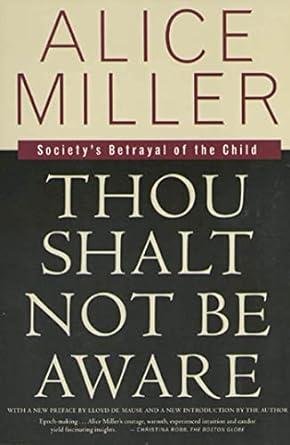Thou Shalt Not Be Aware: Society's Betrayal of the Child
Introduction
Alice Miller's "Thou Shalt Not Be Aware: Society's Betrayal of the Child" is a groundbreaking work that delves into the hidden and often ignored traumas of childhood. Miller, a renowned psychologist, presents a compelling case for how society systematically betrays children by perpetuating and normalizing their suffering. This article explores the key themes of the book, its impact, and the urgent need for societal change to protect and nurture the emotional well-being of children.
The Hidden Trauma of Childhood
Miller's primary thesis is that childhood trauma is often hidden, dismissed, or normalized by society. She argues that the emotional and physical abuse children endure leaves deep, lasting scars that affect their entire lives. The silence surrounding these traumas is maintained by a cultural and social structure that prioritizes the maintenance of familial and societal norms over the well-being of the individual child.
In many families, the abusive behaviors of parents or guardians are rationalized or excused as discipline or necessary tough love. This normalization of abuse perpetuates a cycle of trauma, as the affected children often grow up to repeat the same behaviors with their offspring. Miller contends that this cycle can only be broken by acknowledging and addressing the true extent of childhood suffering.
The Role of Society in Perpetuating Trauma
Miller is particularly critical of how societal institutions, including schools, religious organizations, and the medical profession, often contribute to the suppression of children's traumas. Educational systems frequently prioritize conformity and obedience over the emotional needs of children, further silencing their pain. Similarly, religious doctrines can reinforce the idea that suffering is a necessary part of growth, discouraging children from speaking out about their abuse.
The medical community, too, has been complicit in this betrayal. For years, psychological theories often blamed children for their behavioral issues without considering the impact of their upbringing. This victim-blaming approach overlooks the root causes of the trauma and fails to provide the necessary support and intervention for healing.
Breaking the Silence
One of the most powerful aspects of Miller's work is her call to break the silence surrounding childhood trauma. She emphasizes the importance of listening to children and validating their experiences. By doing so, society can begin to heal the wounds inflicted on its youngest members.
Miller also advocates for the need to educate parents, caregivers, and professionals about the realities of childhood trauma. She believes that a deeper understanding of the impact of abuse and neglect can lead to more compassionate and effective approaches to parenting and care. This education should include recognizing the signs of trauma, understanding its long-term effects, and learning how to support healing and recovery.
The Path to Healing
Healing from childhood trauma is a complex and multifaceted process. Miller highlights several key components necessary for this journey. First and foremost is the need for survivors to confront and acknowledge their pain. This often requires a safe and supportive environment where they can express their feelings without fear of judgment or retribution.
Therapy and counseling can play a crucial role in this process. Professionals trained in trauma-informed care can help survivors navigate their emotions and develop coping strategies. Miller also underscores the importance of building supportive relationships. A strong network of friends, family, and community members who understand and validate the survivor's experiences can provide a vital foundation for recovery.
The Role of Art and Creativity
Miller also explores the therapeutic potential of art and creativity in healing from trauma. Artistic expression allows individuals to process their emotions in a non-verbal way, which can be particularly valuable for those who find it difficult to articulate their pain. Through writing, painting, music, and other forms of creative expression, survivors can explore their inner worlds and begin to make sense of their experiences.
Creative outlets provide a means of reclaiming one's narrative and gaining a sense of control and agency. This empowerment is essential for rebuilding self-esteem and fostering resilience. Miller encourages survivors to find their unique voice and use it to tell their stories, thereby transforming their trauma into a source of strength and inspiration.
Societal Change and Advocacy
Miller's work also calls for broader societal change. She argues that protecting children from trauma should be a collective responsibility, requiring concerted efforts from individuals, communities, and institutions. Advocacy and policy change are crucial components of this endeavor.
Policies that prioritize child welfare, such as improved child protection laws, better access to mental health services, and educational reforms that emphasize emotional intelligence and empathy, can create a safer and more supportive environment for children. Additionally, public awareness campaigns can help destigmatize trauma and encourage more open conversations about its impact.
Conclusion
"Thou Shalt Not Be Aware: Society's Betrayal of the Child" is a powerful and urgent call to action. Alice Miller's profound insights into the hidden traumas of childhood and the societal structures that perpetuate them challenge us to reevaluate our attitudes and practices. By breaking the silence, educating ourselves and others, and advocating for systemic change, we can begin to heal the wounds of the past and build a future where every child is safe, heard, and valued. Miller's work is a testament to the resilience of the human spirit and the transformative power of awareness and compassion.
